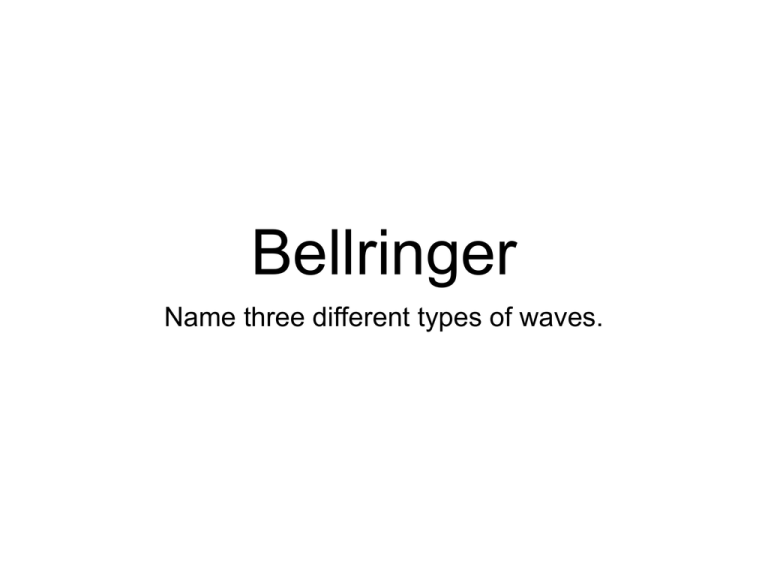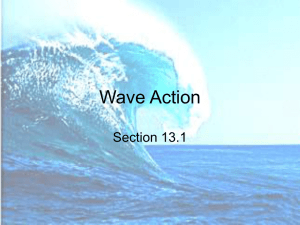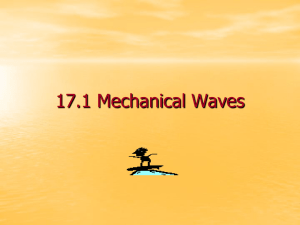wave - Madison County Schools
advertisement

Bellringer Name three different types of waves. Characteristics of Waves Part 1 Waves and Energy • A wave is a type of mov’t that carries energy from place to place. Energy is what you need to do work. • If you shake one end of a rope up and down, a wave travels through the rope. The wave in the rope carries energy from your hand. Waves and Energy • A mechanical wave is a wave that must have material to travel through. The material a mechanical wave travels through is called a medium. • A wave is a rope is a mechanical wave. The rope is the medium. Waves and Energy • Conversely, Electromagnetic waves do not require a medium to transfer energy. • Visible light and radio waves are examples of electromagnetic waves. Waves and Energy • A mechanical wave starts with a vibration. A vibration is a repeated upand-down or back-and-forth movement. • The vibration that starts a rope wave is the up-and-down mov’t of your hand. Types of Mechanical Waves • Transverse waves move the medium up and down. A wave in a rope is a transverse wave. • Longitudinal waves move the medium back and forth. A wave in a spring toy (Slinky) is a longitudinal wave. Parts of a Wave • A transverse wave is composed of two parts. • A crest is the highest point of the wave. • A trough is the lowest point of a wave. Parts of a Wave • A longitudinal wave is composed of two parts. • Compressions are the parts of the wave that are closest together. • Rarefactions are the parts of the wave that are spread out. Properties of Waves • • • Amplitude is how far the medium moves when a wave passes through it. For a transverse wave, amplitude is how far the medium moves up or down. For a longitudinal wave, amplitude is how far the medium moves back or forth. Amplitude shows how much energy the wave has. The more energy the wave has, the bigger the amplitude of the wave. Properties of Waves • Wavelength is how far a wave travels before it starts to repeat. To find the wavelength of a transverse wave, you can measure the distance between the crest of one wave to the crest of the next wave. Or the distance between to adjacent troughs. • Wavelength is usually represented by the Greek letter lambda (λ). Properties of Waves • • • • • Frequency is the number of waves that go by a point in a certain amount of time. Frequency is measured in units called hertz (Hz). If one wave passes a point each second, the frequency is 1Hz. If two waves pass a point each second, the frequency is 2Hz. Remember electricity, where 1 coulomb per second = 1 amp. This is known as current. In waves, 1 wave per second = 1Hz. This is known as frequency. This is named after Heinrich Hertz, who is the German scientist who discovered radio waves. Properties of Waves •Speed is how far a wave travels in a given amount of time. •For example, if a wave travels 5cm in 1 second, its speed is 5cm per second. •Therefore, •Speed = Wavelength x Frequency •or •speed (m/s) = λ (m) × f (Hz) Wave Speed s = Speed measured in meters per second (m/s) s f = Frequency measured in Herts (Hz) λ f λ = wavelength measured in meters Wave Speed • A wave has a length of 4cm, and a frequency of 1 wave per second. What is the wave’s speed? Wave Speed • A wave is found to be 3m long and travels at 4 waves per second. What is its speed? Wave Speed • A wave is traveling at 10 m/s and has a length of 14 mm. What is the wave’s frequency?







